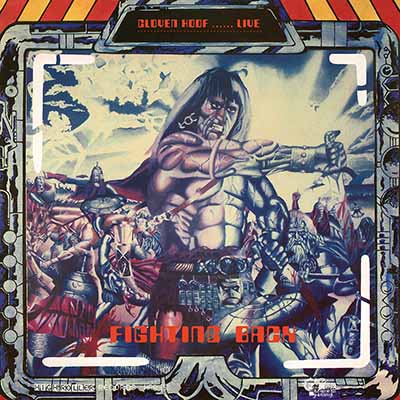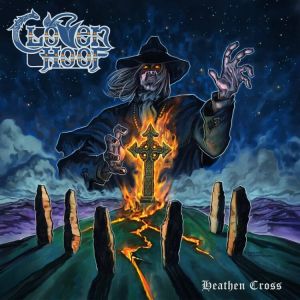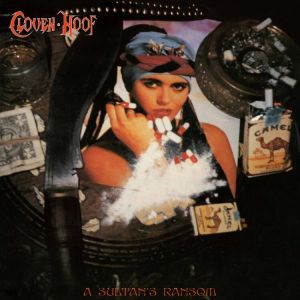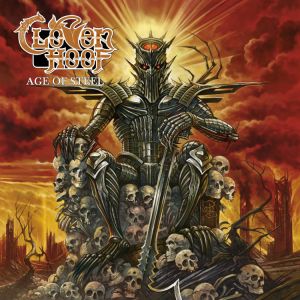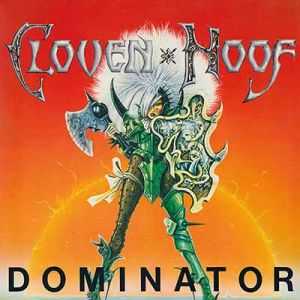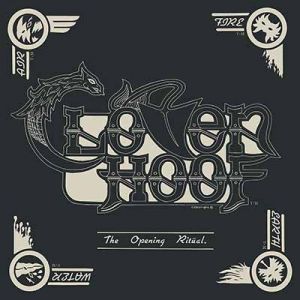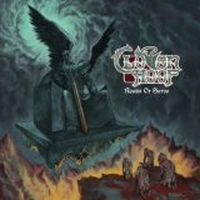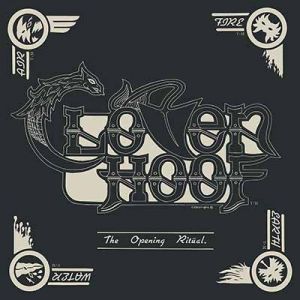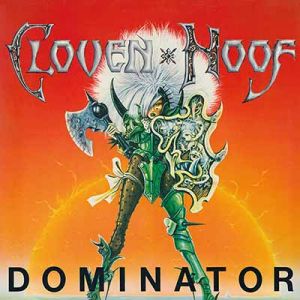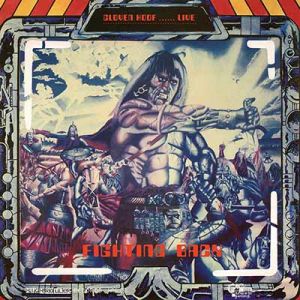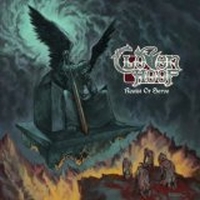Tracklist
01
Reach For The Sky
02
The Fugitive
03
Daughter Of Darkness
04
Raised On Rock
05
Heavy Metal Men Of Steel
06
Break It Up
07
Could This Be Love
08
Eye Of The Sun
Description
Midlands outfit Cloven Hoof must rate as one of the most legendary bands of the entire New Wave Of British Heavy Metal movement. The origins of the group go back to the year 1979, when they first formed under the name of Nightstalker. In 1981, however, the band switched to their new moniker: Cloven Hoof. Original vocalist David Potter, guitarist Steve Rounds, drummer Kevin Poutney and main man Lee Payne on bass adopted the stage characters of 'Earth', 'Fire', 'Water' and 'Air'. A very interesting concept which was far ahead of its time. After recording demos of songs such as "Return Of The Passover" and "Nightstalker" Cloven Hoof issued their debut vinyl 12" EP »The Opening Ritual« on Elemental Music in 1982 (today a precious collector's item). In 1984, the self-titled Cloven Hoof album was released, followed by »Fighting Back« in 1986).
Officially, »Fighting Back« was issued as a "live" album. In the decades after its original release a lot of people wondered how "live" the recording actually was? According to Coven Hoof mastermind Lee Payne, there is no simple answer to this question: "The main problem whilst recording the album was Kevin, the drummer, insisted in using midi drums. He wanted to embrace new technology and believed in the possibility of getting a good sampled sound consistently in a live environment. Good in theory of course, but this technology was in its infancy in those days and the drums didn't quite cut it like today. He played to a click track brilliantly and synth sounds like keyboards were supposed to be triggered but guess what? Most of the stabs didn't work! Computers are fine when they work but back then they were very unreliable. This was before Priest with the »Turbo« album, so bravo to Kevin being at the cutting edge I suppose. The guitars and bass fared better of course they were close miked and the bass was DI'd through the desk with a single mike to the cabs also. The trouble was apart from some crowd spillage through the vocal mikes it was hard to hear the audience. I don't know what the producer did to boost the crowd noise, maybe he just boosted it through one of the backing vocal mikes left on. Certainly when I heard the initial mix, I remember commenting we may as well have played in the rehearsal room and recorded that! The external crowd miking was non-existent, I don't think the stage technicians considered it for a moment. If they had put mikes dedicated purely to picking up the audience, it would have been much better. The stage hands will have to hold their hands up to that one... they fucked up big style. Whatever happened, I was very pleased with the playing. The band sounded very tight indeed. Therefore I am very forgiving about the hotch-potch crowd mixing, and the band didn't do any overdubs whatsoever."
After the EP and the first album Cloven Hoof decided to release this "live" record. There were no previously released songs on the album whatsoever, so that made it even more odd for a "live" album... "We wanted to try out new material, so we thought the best way to air the new songs was by taking it out onto the road and see what the people thought of them," explains Lee Payne. "OK in theory but when a crowd hears songs for the first time they react differently to the old classics. Even so the tunes got a good reaction, so that boded well for a re-recorded studio version of the tracks. 'Eye Of The Sun' and 'Reach For The Sky' actually did make it back onto later albums, but others were so good we felt that they didn't' need reworking as they were perfect as they were. It was very original to play a set of entirely new songs and record them for a live album and we were all for taking risks and breaking new ground. Ah for the braveness of youth! We were unafraid to do anything in those days, we were naive, I guess."
And where did the idea to cover "Daughter Of Darkness" by Tom Jones come from? "Great question!," muses Lee Payne. "We decided that like many bands such as Rainbow, it would be cool to take an obscure song and metal it up for a possible single release. In the end my mom's suggestion of a Tom Jones song that she liked would prove to be the perfect one to tackle. The Sensational Alex Harvey Band did a great job with 'Delilah' previously and Tom has a very powerful vocal delivery, he would have made a great metal singer, I feel. So all we had to do is arrange the piece for guitar and give it fresh dynamics. I thought it worked well and Kerrang! magazine called it 'inspired', so that can't be bad, can it? Later on, however, this choice of artist would lead to our undoing as Russ North decided to imitate the Welsh singer to an alarming degree after the »Dominator« and »A Sultans Ransom« albums, unfortunately."
Would it be fair to say that "Heavy Metal Men Of Steel" was the centrepiece of the record? "Yes, 'Heavy Metal Men of Steel' is my favourite," confesses Lee Payne, "and it would be good to re-record the track one day. I have written a concept album piece around it, too. Watch this space! We decided to adopt the superhero 'Heavy Metal Men of Steel' concept costumes on the back cover. Because of this we got the offer to do a photo session for Kerrang! magazine with the famous metal photographer Ray Palmer. The band W.A.S.P. were in the morning session and Tina Turner and us were in the afternoon. When we got there, Ray was walking as if he had lumbago. We told him he should visit the doctors with his back then he revealed every time one of W.A.S.P. went past him they slapped him hard between the shoulder blades as they went past. His back was red raw like chopped liver... it was their sense of humour, I guess! We were no trouble at all, except our vocalist tried to steal the chair Tina Turner had used before we got there... Hmm, I wonder why? He was a very bad man!"
Did this number also influence the choice of the cover artwork? I mean, when I hear the title "Heavy Metal Men Of Steel", instantly the name Manowar springs to my mind. Were Cloven Hoof aware of Manowar back in 1986? Did they influence them in any way? (Or maybe even the other way round, Cloven Hoof influenced Manowar, who knows?). Lee Payne: "The title »Fighting Back« definitely made me think of Conan. I was obsessed by the Robert E Howard books and the character was my favourite hero of all time. I bought all of them after at first liking the Marvel comics incarnation. Howard was a genius at telling tales of high adventure sword and sorcery. I was always drawing pictures of Conan in my school books and when I got to illustrate a book cover in art college, well, it was obvious what subject matter I would draw on. The cover painting was done by me at 18 and I guess I was pretty pleased with it. Without the album »Fighting Back«, Cloven Hoof would not have existed because of all the legal troubles surrounding the band. I saw it at a time to sink or swim and the album was our lifeline to keep on going. The fans bought it thank goodness and supported us. It sent a message across the metal world that Cloven Hoof would keep 'fighting back' and survive against all odds. This notion made me think back to the painting I had done, it symbolises the spirit of the album perfectly. I love Manowar of course and admire their music and imagery, but they were not an influence on me regards »Fighting Back«. Many of our fans like Manowar too and some got into Cloven Hoof because they bought the album drawn in by the album cover art. Both bands play true metal from the heart and the fans know that. Wish we had done a tour together, it would have been an incredible bill. I remember when the debut Manowar album was offered to Heavy Metal Records back in the day, and I told Paul Birch, the record company owner, to sign them as well as Accept for the »Restless And Wild« album. He didn't, and I bet he regrets that decision now. I thought Manowar were great then and I still do now."
»Fighting Back« was issued on Moondancer Records, a very obscure label. "It was set up by a Birmingham business man in order for Cloven Hoof to put out a live album free of the restraints of record companies," stresses Lee Payne. "The label also enabled us to put out an album free of the legal contractual issues that were hampering us at every turn. When David Hemmings, our previous manager, died, some of the people he had done deals with claimed they owned a piece of Cloven Hoof. David Hemmings had worked as road manager for Black Sabbath and had managed Judas Priest and the Pat Travers Band. We were getting sued on a regular basis and for a time no label would take the risk of signing us, even a major label such as CBS. We are eternally grateful to the owner of Moondancer Records as he saved the band for sure. I can't name him here unfortunately, for legal reasons."
Rob Hendrick is singing on »Fighting Back«", how did this change of singers influence the direction of the band? "Rob Kendrick was a pretty good fit," says Lee Payne, "because he was previously in the bands Trapeze and Budgie. He joined Trapeze at a pretty young age because he was a kind of prodigy on the guitar. His voice was excellent and he modelled himself a little on Glenn Hughes, that was another reason Trapeze hired him. Glenn had left of course to join Deep Purple. Rob sent us a demo tape and we were immediately impressed by the quality of his voice, the guy certainly knew how to sell a song. We saw the potential to use his guitar skills, too, particularly on twin lead parts, before that we were strictly a four piece musically. Two guitars really made everything sound fatter and filled out the rhythms nicely. Having the facility to do two guitar parts definitely influenced me to write 'Reach For The Sky', for example. Rob was really keen on having strong melody lines so he pushed me to be more creative with vocal parts using harmonies to enrich the chorus parts. The previous singer Dave Potter was an all out metal singer and he didn't care much for harmonies, he wanted to keep it hard hitting as we could. It is important to not overdo the harmonies though because they can soften the song up too much and you lose the attack. American AOR bands do that so well but they lose out on raw power and energy, I feel. I think Cloven Hoof have a good medium combining aggression with classy sounding chorus sections that the audience can sing along with live. Mr Kendrick definitely was instrumental in getting me to think about these things in earnest."
Matthias Mader
Officially, »Fighting Back« was issued as a "live" album. In the decades after its original release a lot of people wondered how "live" the recording actually was? According to Coven Hoof mastermind Lee Payne, there is no simple answer to this question: "The main problem whilst recording the album was Kevin, the drummer, insisted in using midi drums. He wanted to embrace new technology and believed in the possibility of getting a good sampled sound consistently in a live environment. Good in theory of course, but this technology was in its infancy in those days and the drums didn't quite cut it like today. He played to a click track brilliantly and synth sounds like keyboards were supposed to be triggered but guess what? Most of the stabs didn't work! Computers are fine when they work but back then they were very unreliable. This was before Priest with the »Turbo« album, so bravo to Kevin being at the cutting edge I suppose. The guitars and bass fared better of course they were close miked and the bass was DI'd through the desk with a single mike to the cabs also. The trouble was apart from some crowd spillage through the vocal mikes it was hard to hear the audience. I don't know what the producer did to boost the crowd noise, maybe he just boosted it through one of the backing vocal mikes left on. Certainly when I heard the initial mix, I remember commenting we may as well have played in the rehearsal room and recorded that! The external crowd miking was non-existent, I don't think the stage technicians considered it for a moment. If they had put mikes dedicated purely to picking up the audience, it would have been much better. The stage hands will have to hold their hands up to that one... they fucked up big style. Whatever happened, I was very pleased with the playing. The band sounded very tight indeed. Therefore I am very forgiving about the hotch-potch crowd mixing, and the band didn't do any overdubs whatsoever."
After the EP and the first album Cloven Hoof decided to release this "live" record. There were no previously released songs on the album whatsoever, so that made it even more odd for a "live" album... "We wanted to try out new material, so we thought the best way to air the new songs was by taking it out onto the road and see what the people thought of them," explains Lee Payne. "OK in theory but when a crowd hears songs for the first time they react differently to the old classics. Even so the tunes got a good reaction, so that boded well for a re-recorded studio version of the tracks. 'Eye Of The Sun' and 'Reach For The Sky' actually did make it back onto later albums, but others were so good we felt that they didn't' need reworking as they were perfect as they were. It was very original to play a set of entirely new songs and record them for a live album and we were all for taking risks and breaking new ground. Ah for the braveness of youth! We were unafraid to do anything in those days, we were naive, I guess."
And where did the idea to cover "Daughter Of Darkness" by Tom Jones come from? "Great question!," muses Lee Payne. "We decided that like many bands such as Rainbow, it would be cool to take an obscure song and metal it up for a possible single release. In the end my mom's suggestion of a Tom Jones song that she liked would prove to be the perfect one to tackle. The Sensational Alex Harvey Band did a great job with 'Delilah' previously and Tom has a very powerful vocal delivery, he would have made a great metal singer, I feel. So all we had to do is arrange the piece for guitar and give it fresh dynamics. I thought it worked well and Kerrang! magazine called it 'inspired', so that can't be bad, can it? Later on, however, this choice of artist would lead to our undoing as Russ North decided to imitate the Welsh singer to an alarming degree after the »Dominator« and »A Sultans Ransom« albums, unfortunately."
Would it be fair to say that "Heavy Metal Men Of Steel" was the centrepiece of the record? "Yes, 'Heavy Metal Men of Steel' is my favourite," confesses Lee Payne, "and it would be good to re-record the track one day. I have written a concept album piece around it, too. Watch this space! We decided to adopt the superhero 'Heavy Metal Men of Steel' concept costumes on the back cover. Because of this we got the offer to do a photo session for Kerrang! magazine with the famous metal photographer Ray Palmer. The band W.A.S.P. were in the morning session and Tina Turner and us were in the afternoon. When we got there, Ray was walking as if he had lumbago. We told him he should visit the doctors with his back then he revealed every time one of W.A.S.P. went past him they slapped him hard between the shoulder blades as they went past. His back was red raw like chopped liver... it was their sense of humour, I guess! We were no trouble at all, except our vocalist tried to steal the chair Tina Turner had used before we got there... Hmm, I wonder why? He was a very bad man!"
Did this number also influence the choice of the cover artwork? I mean, when I hear the title "Heavy Metal Men Of Steel", instantly the name Manowar springs to my mind. Were Cloven Hoof aware of Manowar back in 1986? Did they influence them in any way? (Or maybe even the other way round, Cloven Hoof influenced Manowar, who knows?). Lee Payne: "The title »Fighting Back« definitely made me think of Conan. I was obsessed by the Robert E Howard books and the character was my favourite hero of all time. I bought all of them after at first liking the Marvel comics incarnation. Howard was a genius at telling tales of high adventure sword and sorcery. I was always drawing pictures of Conan in my school books and when I got to illustrate a book cover in art college, well, it was obvious what subject matter I would draw on. The cover painting was done by me at 18 and I guess I was pretty pleased with it. Without the album »Fighting Back«, Cloven Hoof would not have existed because of all the legal troubles surrounding the band. I saw it at a time to sink or swim and the album was our lifeline to keep on going. The fans bought it thank goodness and supported us. It sent a message across the metal world that Cloven Hoof would keep 'fighting back' and survive against all odds. This notion made me think back to the painting I had done, it symbolises the spirit of the album perfectly. I love Manowar of course and admire their music and imagery, but they were not an influence on me regards »Fighting Back«. Many of our fans like Manowar too and some got into Cloven Hoof because they bought the album drawn in by the album cover art. Both bands play true metal from the heart and the fans know that. Wish we had done a tour together, it would have been an incredible bill. I remember when the debut Manowar album was offered to Heavy Metal Records back in the day, and I told Paul Birch, the record company owner, to sign them as well as Accept for the »Restless And Wild« album. He didn't, and I bet he regrets that decision now. I thought Manowar were great then and I still do now."
»Fighting Back« was issued on Moondancer Records, a very obscure label. "It was set up by a Birmingham business man in order for Cloven Hoof to put out a live album free of the restraints of record companies," stresses Lee Payne. "The label also enabled us to put out an album free of the legal contractual issues that were hampering us at every turn. When David Hemmings, our previous manager, died, some of the people he had done deals with claimed they owned a piece of Cloven Hoof. David Hemmings had worked as road manager for Black Sabbath and had managed Judas Priest and the Pat Travers Band. We were getting sued on a regular basis and for a time no label would take the risk of signing us, even a major label such as CBS. We are eternally grateful to the owner of Moondancer Records as he saved the band for sure. I can't name him here unfortunately, for legal reasons."
Rob Hendrick is singing on »Fighting Back«", how did this change of singers influence the direction of the band? "Rob Kendrick was a pretty good fit," says Lee Payne, "because he was previously in the bands Trapeze and Budgie. He joined Trapeze at a pretty young age because he was a kind of prodigy on the guitar. His voice was excellent and he modelled himself a little on Glenn Hughes, that was another reason Trapeze hired him. Glenn had left of course to join Deep Purple. Rob sent us a demo tape and we were immediately impressed by the quality of his voice, the guy certainly knew how to sell a song. We saw the potential to use his guitar skills, too, particularly on twin lead parts, before that we were strictly a four piece musically. Two guitars really made everything sound fatter and filled out the rhythms nicely. Having the facility to do two guitar parts definitely influenced me to write 'Reach For The Sky', for example. Rob was really keen on having strong melody lines so he pushed me to be more creative with vocal parts using harmonies to enrich the chorus parts. The previous singer Dave Potter was an all out metal singer and he didn't care much for harmonies, he wanted to keep it hard hitting as we could. It is important to not overdo the harmonies though because they can soften the song up too much and you lose the attack. American AOR bands do that so well but they lose out on raw power and energy, I feel. I think Cloven Hoof have a good medium combining aggression with classy sounding chorus sections that the audience can sing along with live. Mr Kendrick definitely was instrumental in getting me to think about these things in earnest."
Matthias Mader
 The Power Of Rock
The Power Of Rock $ US
$ US